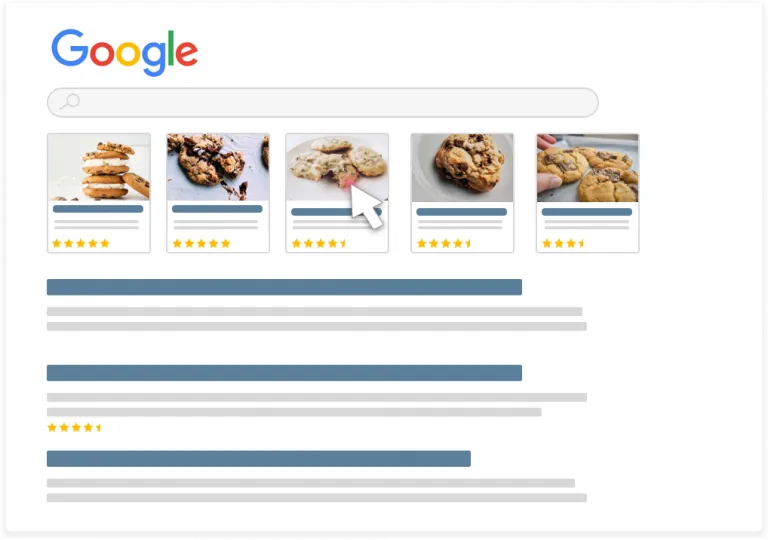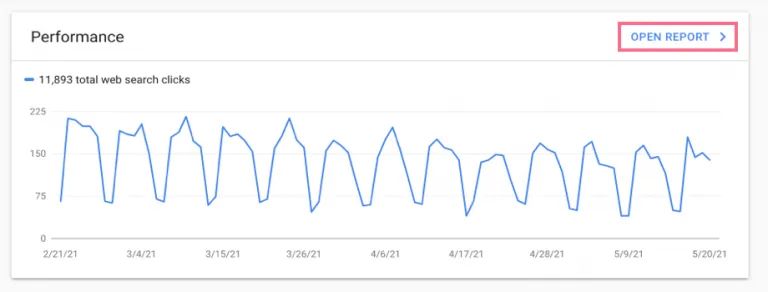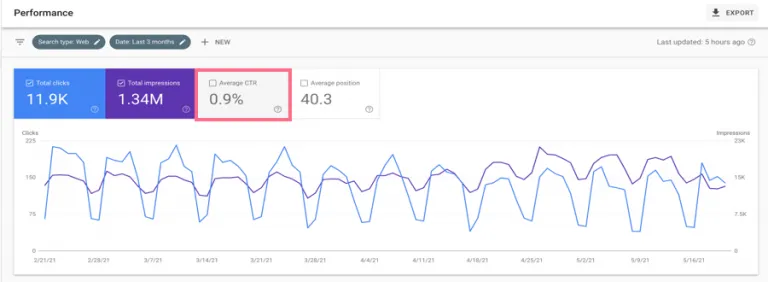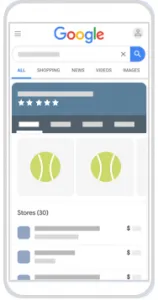How to Improve Your Organic Click-through Rate

Search engine optimization is one of the best ways to get more inbound, organic traffic coming to your website. That means, if you want to get people to your website, you need to understand how to optimize your web content to rank higher in Google search results for relevant search queries.
Of course, one of the best ways to rank for search queries is to understand the keywords searchers use to ask their questions and then write content that helps solve their problem or answer their question.
But what happens after you create the content and optimize it to rank? The next step is to get users to actually click on your web page in search results — which means increasing your impressions, clicks, and overall click-through rate (CTR).
Table of Contents
- How to Calculate CTR
- Search Results Page Position and CTR
- Improve Organic CTR with Technical SEO
- 5 proven ways to increase organic CTR
- Further Reading
How to Calculate Click-through Rate
Click-through rate can be determined by taking the number of impressions you get for a specific web page and dividing that by the number of clicks you get to that web page.
Clicks ÷ impressions = CTR. For example, if you had 6 clicks and 100 impressions, then your CTR would be 6%.
How to Find CTR in Google Search Console:
Here’s how to find CTR using Google Search Console:
- Start at the Google Search Console Overview page.
- Find the Performance report and click on “OPEN REPORT”

- When you open the report, you will see an overview of the organic impressions, clicks, and click-through rate for your website.

The click-through rate reflects the number of people that are seeing your web page and are choosing to click on that page. This means that the click-through rate is almost entirely dependent on howyour site appears in Google search results and which position it appears in.
You may think your ability to influence organic click-through rates in this way is limited, but actually, you’ll find there are a lot of technical SEO tactics you can do to increase organic CTR.
Search Results Page Position and CTR
Before we dive into the various tactics you should implement to stand out in the search engine results pages (SERPs), it’s important to note the correlation between SERP position (search rankings) and organic click-through rate.
Research conducted by Backlinko shows that websites that rank higher in search results have a drastically higher organic CTR than websites that rank lower on the SERP — even on page 1 of the search results. And sites that rank within the top 3 positions perform the best.
- The #1 result in Google’s search results has an average organic CTR of 31.7%.
- The #1 organic result is 10x more likely to receive a click compared to a page in #10 spot.
- On average, moving up 1 spot in the search results will increase CTR by 30.8%. Of course, the jump in CTR depends on which position your site is moving from. When sites move from 10 to 9 they will see less of an increase in clicks than if they moved from 3 to 2.
Improve Organic Click-through Rate with Technical SEO
The technical SEO tactics you can implement to improve CTR from organic search results work either by manipulating the content structure on a web page or by adding structured data markup (in the context of schema.org).
Content structure
The content structure typically helps search engines contextualize content better and understand its purpose to better rank that content. It also includes edits to things like titles and meta descriptions that provide more information on a SERP to search engine users and can sway them to click.
Structured Data Markup
Structured data markup (in the context of schema.org) provides additional information to search engines about the content of your website. This qualifies your content for rich snippets in search results (more on rich snippets later).
Here are 5 proven ways to increase your organic click-through rate
Write Compelling, relevant Title Tags
Title tags can be the difference between a user wanting to click onto your web page from search results, and from a user scrolling past your result.
- Title tags that contain a question have a 14.1% higher CTR vs. pages that don’t have a question in their title. (Source: Backlinko)
- Title tags between 15 to 40 characters have the highest CTR. According to our data, pages with a title tag length between 15 and 40 characters have an 8.6% higher CTR compared to those that are outside of that range. (Source: Backlinko)
Write Compelling, Keyword-rich Meta Descriptions
Like title tags, meta descriptions can be the difference between a user wanting to click onto your web page from search results, and from a user scrolling past your result.
- Writing meta descriptions for your pages may result in a higher CTR.Pages with a meta description get 5.8% more clicks than those without a description.(Source: Backlinko)
For sites that deal in e-commerce, it’s also important that your product descriptions are useful to the user and address any questions or concerns they may have. For the best results, fill out all the recommended product description information in Google Merchant according to the Google Merchant documentation.

Metadata also provides search engines with more information about the content of your website, which helps your content rank better for relevant search queries.
Implement Structured Data & Rich Snippet Markup
Structured data helps your content qualify for rich snippets like reviews, recipes, FAQs, and video enhancements. Rich snippets — also called rich results — improve organic click-through rate by taking up more space on the search engine results page, providing more information to the user about the content of your webpage (enabling a user to make a more informed decision), and by making your search engine results simply visually stand out from other search results.

Rich snippets, generally improve CTR for the reasons mentioned above, but to what extent a rich snippet increases your CTR compared to other search rankings depends on the type of rich snippet.
Structured data also provides search engines with more information about the content of your website, which helps your content rank better for relevant search queries.
Win Featured Snippets
Featured snippets are a featured section of a webpage that appears at the top of a SERP. Featured snippets allow you to increase the chance of users clicking onto your website in order to continue reading the information presented in the featured snippet and they improve brand awareness and brand authority on a given topic.
Featured snippets can appear in one of these formats:
- Paragraph
- List
- Table
- Video
- Accordion

According to research conducted by Moz in 2019, 23% of all SERPs have a featured snippet — which grew 165% since 2016 —and 50% of all those snippets were paragraph featured snippets.

Use Keywords-rich URLs — Which Google May Use as Breadcrumbs
It’s important to use URL nomenclature and structure that corresponds with the content of the webpage and is easy to understand.
Keyword-rich URLs
URLs that contain a keyword have a 45% higher click-through rate compared to URLs that don’t contain a keyword. (Source: Backlinko)
Why is this?
URLs are one of the first things that a search engine crawler sees when determining how to index and rank your website. The rule of thumb when naming a URL is to keep it simple and intelligible — we’ve all seen URLs that include a long string of numbers and special characters, and they are no easier for search engine bots to understand than they are for your users.
Here’s an example of a URL that clearly explains the content of an article and helps a search engine rank the site appropriately:
www.example.com/technical-seo/how-to-improve-click-through-rate
A URL like the one above will always perform better than this:
www.example.com/seobp/627?=article=329001
URL Structure and breadcrumbs
Another thing to consider is whether your URLs are structured in a way that would make sense in a breadcrumb menu. Avoid placing pages in irrelevant folders.
For example, if you have a site as an organic bedding and clothing retailer, you’d want to make sure that your pillowcases page is located here:
www.example.com/bedding/pillowcases

As opposed to here:
www.example.com/clothing/pillowcases
A couple of other SEO best practices are to keep your URL from being overly long without sacrificing descriptiveness and use hyphens as opposed to underscores to separate words.